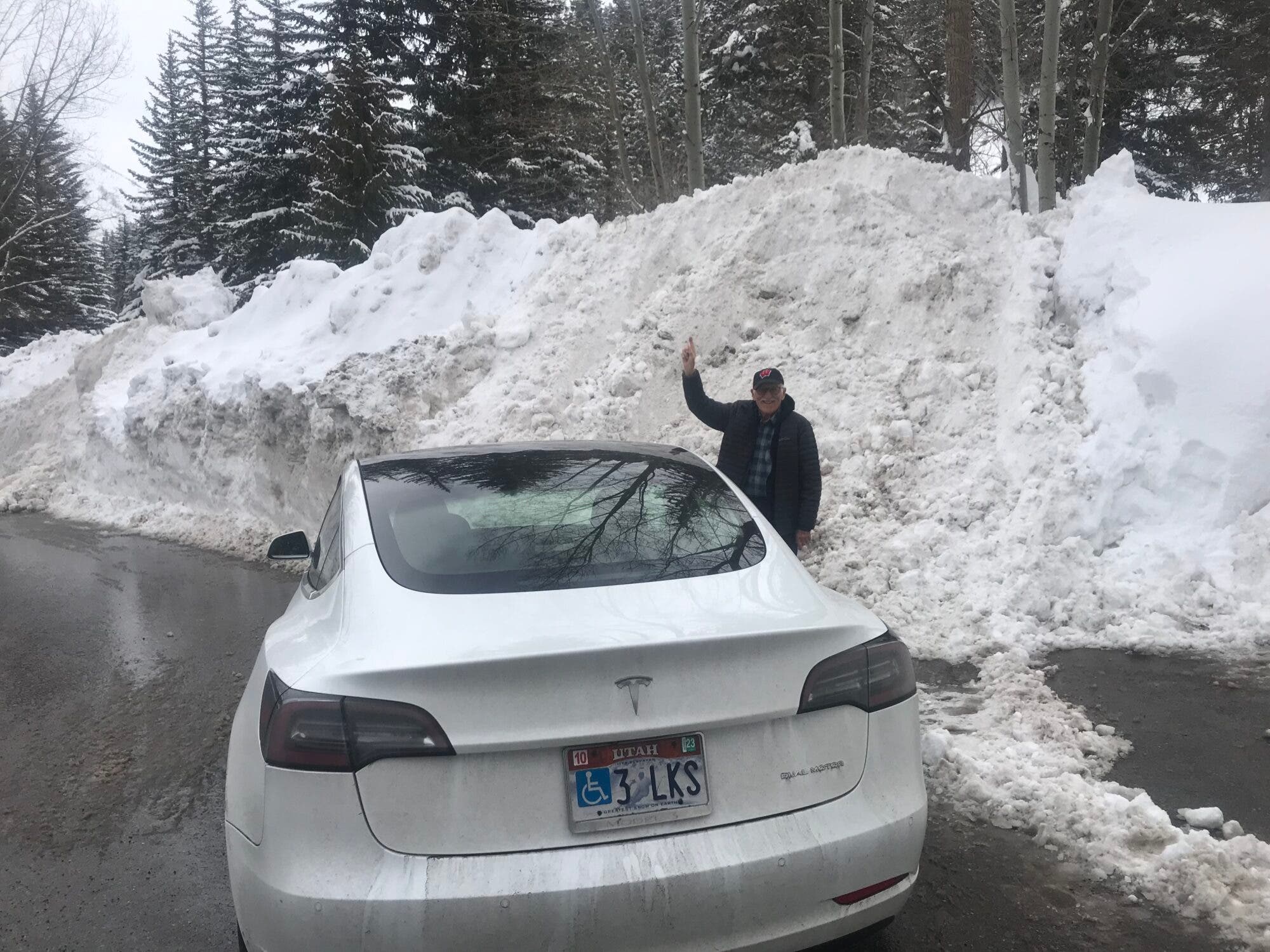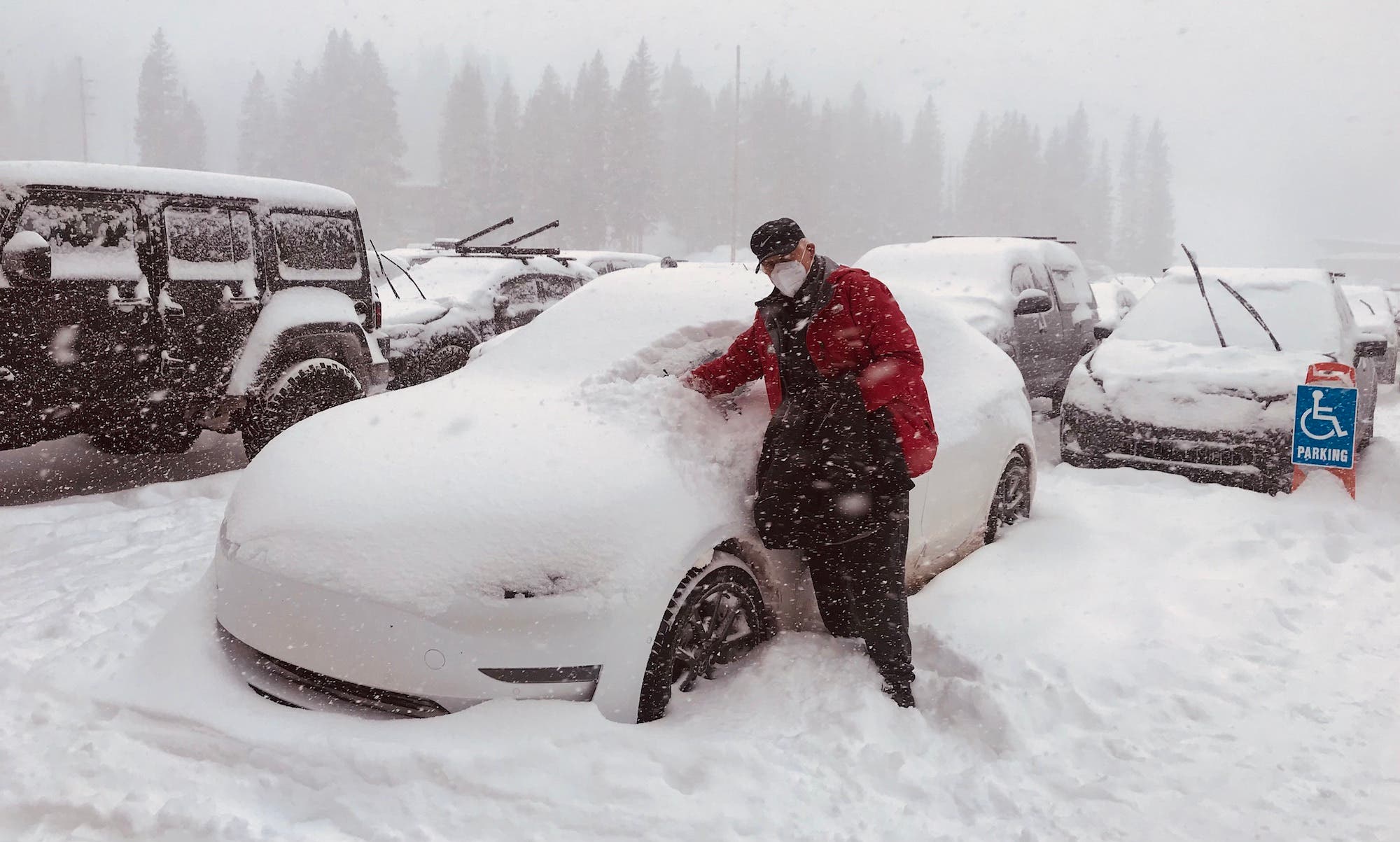The average winter snowfall at Alta, Brighton, Snowbird, and Solitude ski resorts in Utah is 500”. As of this writing, Brighton and Alta Ski Resorts are at 672” and 660” snowfall respectively for the season, and the others are not far behind. With 5 weeks of the ski season left to go, we are well on our way to the 825.5” all-time record set at Alta in 1985. I teach alpine skiing at Brighton, which involves a 16 mile commute up Big Cottonwood Canyon twice a week.

Figure 2: Me and my Tesla Model 3. Monumental snow. Sundance, Utah. March 7, 2023. Photo by Mary Hasler.

Figure 3: My grandson. Monumental snow. Sundance, Utah. March 7, 2023. Photo by Fritz Hasler.
Extreme Winter Driving in Tesla Model 3
I will turn 83 this year, so I have been skiing and traveling to ski resorts in Wisconsin, the Upper Peninsula of Michigan, Colorado, New England, Canada, and the European Alps now for over 70 years. Most of my driving on winter roads in Wisconsin and to ski resorts has been on all-season tires in cars and vans with two-wheel drive. We considered ourselves totally equipped for winter driving when we had a VW Bug with the heavy motor over the rear-drive wheels. When I purchased my Tesla Model 3, my number one requirement was for maximum range because I knew that we would need to make the cross-country commute from Utah to Wisconsin every year.
To me, it was a bonus that the Model 3 Long Range came with dual motors. With a motor on both the front- and rear-drive axles, it is essentially a four-wheel-drive vehicle. On any winter day with new snowfall, Big Cottonwood Canyon in Utah leading to the Solitude and Brighton ski resorts is restricted to vehicles with traction assist. This essentially means four-wheel drive, chains, or studded snow tires. With my previous two-wheel-drive Nissan Leaf electric car, this would mean parking at the bottom and hitchhiking up the canyon on snow days.
With my Tesla Model 3 dual motor, I have been able to drive up Big Cottonwood Canyon even on snow days. This winter, my tires were approaching the wear bars where I would need to replace them. However, I was still making it up the canyon since the Salt Lake County traffic authority plows the road very frequently when it is snowing. However, on January 21, it was snowing heavily as I followed a long line of cars slowly working its way up the canyon. Just 4 miles short of Brighton I started skidding off the road to the right in 4” of fresh powder snow. I was stuck, I couldn’t move frontward or backward. I got out of the car and hitchhiked up to Brighton. I borrowed a shovel and hitchhiked back down to the car. Fortunately, a policeman in a big pickup truck with snow tires was waiting for me at the car. He attached a tow strap to my receiver (installed for attaching a tow ball and my bike rack) and pulled me back on the road so that I was facing downhill.
I drove directly down the Canyon and proceeded immediately to a Les Schwab tire store and bought new all-season tires that had the best tread design (Continental 235/45R-18XL 98Y Extreme Contact mDWS06+) for winter driving in snow (see Figure 4). It was only few days later that I was driving up the canyon when it was snowing heavily and I was able to make it up with only a small amount of trepidation. As a bonus, there was virtually no skidding on my way up.

Figure 4: Continental 235/45R-18XL 98Y Extreme Contact mDWS06+ tire. March 7, 2023. Photo by Fritz Hasler.
The next issue has been the parking lot. The Model 3 has only 5.5” clearance height under the car. When we have 8” of new snow after arrival, as you see in Figure 1, it’s very difficult to get the car moving even with 4-wheel-drive because the car is high centered. It was necessary to dig out each tire with my ski gloves and shovel in front of the car to get enough room to get moving. Also, the parking lot attendants supplied a couple of plastic traction enhancers to put under the tires. Once I was moving, I had to keep going at least 10 mph or I would be stuck again. Fortunately, there were no skiers walking in the road to make me stop.
A few blocks from home, I could hear something scraping under the car. It turned out that I had damaged the fiberboard aero-shield under the car. The purpose of the shield is to enhance the aerodynamics of the car. 8” of compacted snow in the parking lot had scraped the fiberboard right off the bottom of the car. When I presented my car to the Tesla service center for repairs, they replaced the fiberboard aero-shield with a new shield made of plastic. I hope the plastic shield is more durable than the fiber version.
I have learned my lesson: On days with 5” or more snow forecast during the day, I will be parking my car at the bottom of the hill and hitchhiking up the canyon.
Full Self Driving (FSD) Beta Update
I have been using FSD Beta on and off for several months. “Off” would come when I got 5 forced disengagements and Tesla temporarily canceled my access to the software. This happened to me twice and it took a couple of months each time before Tesla restored access to me. I think I have found the solution to maintaining access to FSD Beta. I’ve been using FSD Beta again for a couple of months now and I have had no forced disengagements. I’ve stopped using FSD Beta all the time. On longer trips, it has little utility: autosteer and smart cruise control do the job on the highway and you have little advantage using FSD Beta to drive your car just to the Superchargers. I now use FSD Beta only for shorter city trips where the software is more useful and I can focus on letting the software do its job and intervening when it makes a mistake. Formerly, I would lose focus on longer trips, when I was looking for a charger, changing the navigation, adjusting the heating/cooling, etc.
The biggest improvement I see with latest version of FSD Beta is that it now handles rotaries (roundabouts) properly. Previously, FSD Beta would come to a full stop when entering the rotary even when there were no other cars. Now it treats the rotary entrance like a yield sign, which is what it is supposed to do.
FSD Beta’s biggest fault is still the occasional failure to get in the correct lane (center or turn) to follow the navigation route. The driver has to be constantly on the alert to intervene in this case. The second biggest fault of FSD Beta is that it is too slow, too timid at stop signs and doing unprotected (no traffic light) turns onto busy roads. The simple solution is to intervene by supplying a small amount of pressure to the accelerator to make the car move forward at the proper time. The car will still execute the turn properly.
We are all still waiting anxiously for V.11 of FSD Beta, which is supposed to bring big improvements. Unfortunately, we read that it may be some months before we see the release.
Please add your winter driving tips and FSD Beta experience in the comments section below.
I don’t like paywalls. You don’t like paywalls. Who likes paywalls? Here at CleanTechnica, we implemented a limited paywall for a while, but it always felt wrong — and it was always tough to decide what we should put behind there. In theory, your most exclusive and best content goes behind a paywall. But then fewer people read it! We just don’t like paywalls, and so we’ve decided to ditch ours.
Unfortunately, the media business is still a tough, cut-throat business with tiny margins. It’s a never-ending Olympic challenge to stay above water or even perhaps — gasp — grow. So …

Read the full article here



